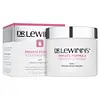What's inside
What's inside
 Key Ingredients
Key Ingredients

 Benefits
Benefits

 Concerns
Concerns

 Ingredients Side-by-side
Ingredients Side-by-side

Water
Skin ConditioningStearyl Dimethicone
EmollientPropylene Glycol
HumectantGlycerin
HumectantHydrolyzed Collagen
EmollientSodium Acetylated Hyaluronate
HumectantCopper Lysinate/Prolinate
Skin ConditioningPanax Ginseng Root Extract
EmollientPortulaca Oleracea Extract
Skin ConditioningCentella Asiatica Extract
CleansingCeramide NP
Skin ConditioningAminobutyric Acid
Biosaccharide Gum-1
HumectantHydrolyzed Keratin
HumectantAgar
MaskingPhenoxyethanol
Preservative1,2-Hexanediol
Skin ConditioningXanthan Gum
EmulsifyingSodium Polyacrylate
AbsorbentPvp
Emulsion StabilisingPolyvinyl Alcohol
Polyacrylamide
C13-14 Isoparaffin
EmollientAcrylates Copolymer
Parfum
MaskingLaureth-7
EmulsifyingDisodium EDTA
Methylglucoside Phosphate
Skin ConditioningCyclopentasiloxane
EmollientPolyvinyl Acetate
Emulsion StabilisingPolysilicone-11
CI 77120
Cosmetic ColorantEthylhexylglycerin
Skin ConditioningCholesterol
EmollientPalmitoyl Tripeptide-5
Skin ConditioningPhytosphingosine
Skin ConditioningBenzyl Salicylate
PerfumingHexyl Cinnamal
PerfumingCitronellol
PerfumingHydroxycitronellal
PerfumingLinalool
PerfumingButylphenyl Methylpropional
PerfumingCI 77491
Cosmetic ColorantWater, Stearyl Dimethicone, Propylene Glycol, Glycerin, Hydrolyzed Collagen, Sodium Acetylated Hyaluronate, Copper Lysinate/Prolinate, Panax Ginseng Root Extract, Portulaca Oleracea Extract, Centella Asiatica Extract, Ceramide NP, Aminobutyric Acid, Biosaccharide Gum-1, Hydrolyzed Keratin, Agar, Phenoxyethanol, 1,2-Hexanediol, Xanthan Gum, Sodium Polyacrylate, Pvp, Polyvinyl Alcohol, Polyacrylamide, C13-14 Isoparaffin, Acrylates Copolymer, Parfum, Laureth-7, Disodium EDTA, Methylglucoside Phosphate, Cyclopentasiloxane, Polyvinyl Acetate, Polysilicone-11, CI 77120, Ethylhexylglycerin, Cholesterol, Palmitoyl Tripeptide-5, Phytosphingosine, Benzyl Salicylate, Hexyl Cinnamal, Citronellol, Hydroxycitronellal, Linalool, Butylphenyl Methylpropional, CI 77491
Water
Skin ConditioningDimethicone
EmollientPrunus Armeniaca Kernel Oil
MaskingGlyceryl Stearate
EmollientPropylene Glycol
HumectantSqualane
EmollientEthylhexyl Methoxycinnamate
UV AbsorberSesamum Indicum Seed Oil
EmollientC12-20 Acid PEG-8 Ester
EmulsifyingCetyl Alcohol
EmollientGlycerin
HumectantSorbitol
HumectantSodium Cetearyl Sulfate
CleansingPanthenol
Skin ConditioningPhenoxyethanol
PreservativeTocopheryl Linoleate
AntioxidantCI 77891
Cosmetic ColorantHydrolyzed Elastin
EmollientRetinyl Palmitate
Skin ConditioningSoluble Collagen
HumectantTocopheryl Acetate
AntioxidantDisodium EDTA
Sodium Dehydroacetate
PreservativeParfum
MaskingLimonene
PerfumingCI 19140
Cosmetic ColorantWater, Dimethicone, Prunus Armeniaca Kernel Oil, Glyceryl Stearate, Propylene Glycol, Squalane, Ethylhexyl Methoxycinnamate, Sesamum Indicum Seed Oil, C12-20 Acid PEG-8 Ester, Cetyl Alcohol, Glycerin, Sorbitol, Sodium Cetearyl Sulfate, Panthenol, Phenoxyethanol, Tocopheryl Linoleate, CI 77891, Hydrolyzed Elastin, Retinyl Palmitate, Soluble Collagen, Tocopheryl Acetate, Disodium EDTA, Sodium Dehydroacetate, Parfum, Limonene, CI 19140
Ingredients Explained
These ingredients are found in both products.
Ingredients higher up in an ingredient list are typically present in a larger amount.
Disodium EDTA plays a role in making products more stable by aiding other preservatives.
It is a chelating agent, meaning it neutralizes metal ions that may be found in a product.
Disodium EDTA is a salt of edetic acid and is found to be safe in cosmetic ingredients.
Learn more about Disodium EDTAGlycerin is already naturally found in your skin. It helps moisturize and protect your skin.
A study from 2016 found glycerin to be more effective as a humectant than AHAs and hyaluronic acid.
As a humectant, it helps the skin stay hydrated by pulling moisture to your skin. The low molecular weight of glycerin allows it to pull moisture into the deeper layers of your skin.
Hydrated skin improves your skin barrier; Your skin barrier helps protect against irritants and bacteria.
Glycerin has also been found to have antimicrobial and antiviral properties. Due to these properties, glycerin is often used in wound and burn treatments.
In cosmetics, glycerin is usually derived from plants such as soybean or palm. However, it can also be sourced from animals, such as tallow or animal fat.
This ingredient is organic, colorless, odorless, and non-toxic.
Glycerin is the name for this ingredient in American English. British English uses Glycerol/Glycerine.
Learn more about GlycerinParfum is a catch-all term for an ingredient or more that is used to give a scent to products.
Also called "fragrance", this ingredient can be a blend of hundreds of chemicals or plant oils. This means every product with "fragrance" or "parfum" in the ingredients list is a different mixture.
For instance, Habanolide is a proprietary trade name for a specific aroma chemical. When used as a fragrance ingredient in cosmetics, most aroma chemicals fall under the broad labeling category of “FRAGRANCE” or “PARFUM” according to EU and US regulations.
The term 'parfum' or 'fragrance' is not regulated in many countries. In many cases, it is up to the brand to define this term.
For instance, many brands choose to label themselves as "fragrance-free" because they are not using synthetic fragrances. However, their products may still contain ingredients such as essential oils that are considered a fragrance by INCI standards.
One example is Calendula flower extract. Calendula is an essential oil that still imparts a scent or 'fragrance'.
Depending on the blend, the ingredients in the mixture can cause allergies and sensitivities on the skin. Some ingredients that are known EU allergens include linalool and citronellol.
Parfum can also be used to mask or cover an unpleasant scent.
The bottom line is: not all fragrances/parfum/ingredients are created equally. If you are worried about fragrances, we recommend taking a closer look at an ingredient. And of course, we always recommend speaking with a professional.
Learn more about ParfumPhenoxyethanol is a preservative that has germicide, antimicrobial, and aromatic properties. Studies show that phenoxyethanol can prevent microbial growth. By itself, it has a scent that is similar to that of a rose.
It's often used in formulations along with Caprylyl Glycol to preserve the shelf life of products.
Propylene Glycol is an odorless, colorless liquid. As a humectant, it helps skin retain moisture. It also aids in delivering active ingredients.
Another role of this ingredient is preventing a product from melting or freezing. Propylene glycol also adds antimicrobrial properties to a product, elongating product lifespan.
This ingredient is considered an organic alcohol and commonly added into both cosmetics and foods.
Those with sensitive skin or conditions may develop a rash when using this ingredient.
Learn more about Propylene GlycolWater. It's the most common cosmetic ingredient of all. You'll usually see it at the top of ingredient lists, meaning that it makes up the largest part of the product.
So why is it so popular? Water most often acts as a solvent - this means that it helps dissolve other ingredients into the formulation.
You'll also recognize water as that liquid we all need to stay alive. If you see this, drink a glass of water. Stay hydrated!
Learn more about Water